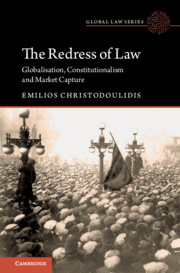Book contents
- Reviews
- The Redress of Law
- Global Law Series
- The Redress of Law
- Copyright page
- Dedication
- Contents
- Acknowledgements
- Introduction
- Part I Political Phenomenology
- Part II Political Constitutionalism
- Part III Market Constitutionalism
- 3.1 Market Trajectories
- 3.2 Total Market Thinking
- 3.3 Europe’s ‘Social Market’ and the Disembedding of Labour Protection
- 3.4 The Deep Commodification of Labour
- Part IV Strategies of Redress
- Epilogue
- References
- Index
3.3 - Europe’s ‘Social Market’ and the Disembedding of Labour Protection
from Part III - Market Constitutionalism
Published online by Cambridge University Press: 26 March 2021
- Reviews
- The Redress of Law
- Global Law Series
- The Redress of Law
- Copyright page
- Dedication
- Contents
- Acknowledgements
- Introduction
- Part I Political Phenomenology
- Part II Political Constitutionalism
- Part III Market Constitutionalism
- 3.1 Market Trajectories
- 3.2 Total Market Thinking
- 3.3 Europe’s ‘Social Market’ and the Disembedding of Labour Protection
- 3.4 The Deep Commodification of Labour
- Part IV Strategies of Redress
- Epilogue
- References
- Index
Summary
What the Rome Treaty inaugurated, what set the European project on its course and fuelled its rapid acceleration, was an original asymmetry, a coupure into the fabric of European societies. It cut into the political economy in order to replicate at the European level the radical separation of the political from the economic system, that was the hallmark of the liberal settlement of post-war Germany. But once uploaded to the transnational, European, level, the separation generated an asymmetry between the differentiated systems, the economic system uploaded to the transnational level and the political system left tied to democratic processes and solidarity-based institutions at the national level, an asymmetry that assumed its own momentum. The magnitude of the breach and the effects of the asymmetric configuration of supranational and national, can only be appreciated in retrospect. This chapter will explore those effects, that have gradually led to the disembedding of Europe’s economy from its society.1 As ‘ordoliberalism’ was stormed by ‘neoliberalism’, to the detriment of what the post-war consensus had allowed to function on a human scale, this was a disembedding that became increasingly difficult to control, let alone reverse. We are today depressingly familiar with the way in which the institutionalisation of the separation between market economy and social protection was set on a trajectory where it became productive for capital, to the point where the profit margins have become staggering and the effects devastating. It is not the way the story of the European Union is customarily told, to focus it on asymmetry, on breach, on time, and on the surplus value extracted from the processes of evasion and elision that it sets in motion. But with hindsight, it is nevertheless what holds the key to the European misadventure.
- Type
- Chapter
- Information
- The Redress of LawGlobalisation, Constitutionalism and Market Capture, pp. 365 - 394Publisher: Cambridge University PressPrint publication year: 2021

